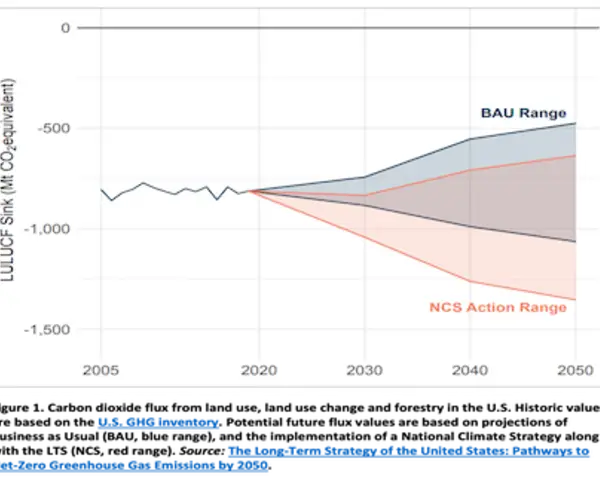The Biden Administration recently published the Long Term Strategy of the United States, outlining different pathways the nation can take to reduce greenhouse gas (GHG) emissions to net-zero by 2050.
The U.S. has committed to reducing GHG emissions by 50-52% below 2005 levels by 2030, and to achieving net-zero emissions by 2050. These commitments are in-line with the levels of mitigation scientists say are needed to avoid dangerous effects of climate change.
The Long Term Strategy (LTS) provides a roadmap for how the nation will meet this net-zero goal by 2050. Important steps in this roadmap include decarbonizing the electricity system, electrifying the transportation sector, improving energy system efficiency, and reducing non-CO2 greenhouse gases from industry and agriculture.
Another key component of the LTS roadmap will be the strengthening of the land carbon sink, which in 2019 offset more than 12% of economy-wide emissions, via absorption of carbon in plant biomass and soils. The activities referenced in the LTS to enhance the land carbon sink include protecting, expanding, and improving the management of forest lands, preventing forest fires, planting trees in urban and agricultural lands, and scaling up climate-smart agriculture practices.
The LTS projects that the land sink could remove an additional 100-300 million tons of CO2 from the atmosphere annually by mid-century. Here are six more things you should know about the potential role of the land carbon sink in the LTS:

- The U.S. land carbon sink goal can contribute to a global effort to end deforestation. Just this week more than 100 countries including the U.S., representing roughly 85% of the world’s forests, committed to ending deforestation and conserving terrestrial ecosystems.
- Enhancing the U.S. land carbon sink will be critical for achieving net-zero goals in a cost-effective way, as decarbonization of some sectors will be technologically challenging and expensive. While estimates of costs range widely, one recent study suggests that land-based mitigation options including forest management interventions and tree planting in the U.S. is relatively inexpensive and could sequester nearly 200 - 440 million metric tons of CO2 per year by mid-century at prices starting at $20/tCO2. The land carbon sink will be especially important in the near-term, as technologies for CO2 removal are still largely under development.
- The future of the land carbon sink in the US is uncertain. Accumulation of carbon in the nation’s forests has been slowing down due in part increasing fire, pest, and disease-related disturbance in some regions. In the future the rate of accumulation will be influenced by difficult-to-predict factors such as CO2 fertilization (which could improve tree productivity), disturbances (which could increase tree mortality), and a wide range in future economic conditions. These uncertainties make it challenging to project how much carbon sequestration will happen on U.S. lands even without new policies or programs to enhance carbon sinks (blue range in Figure 1).
-
Mitigation potential is estimated as a range using multiple models. The projection of mitigation potential from the land carbon sink in the LTS (the red range in Figure 1) is based on the results from multiple economic models of the U.S. forestry and land use system. Most of these models reflect economic opportunity costs of mitigation investments (e.g., reduced revenues from deferred or delayed harvests). Using multiple models better represents variation in mitigation estimates due to a range of different approaches and assumptions, such as differences in spatial coverage (global vs. national), time scale, and inclusion of different product markets. The projected range represents model differences, outcomes from alternative socioeconomic assumptions, and the net effect of different policy incentives (e.g., mitigation prices) on carbon storage.
- There are substantial co-benefits associated with increasing the land carbon sink in the U.S. In addition to helping the U.S. achieve its LTS goals, investments in the land carbon sink can provide a host of environmental and socio-economic co-benefits, ranging from water quality protection, habitat and biodiversity conservation, protecting infrastructure, and improving soil health. Further, improved management of soils and forests to improve carbon sequestration can also provide climate resilience and adaptation benefits— another key component of the U.S. LTS.
- Decarbonization of the energy sector could substantially increase competition for land. The large-scale investments in renewable energy generation envisioned in the LTS are likely require large areas of land in the U.S. This includes land for bioenergy production, and wind and solar power expansion. Such investments could increase competition for land, influencing the potential magnitude and costs of increasing the land carbon sink. Moving forward, new research will be needed to assess land carbon and other socioeconomic tradeoffs associated with a comprehensive range of land-intensive mitigation strategies in the LTS.
Read the full Long Term Strategy to learn more about how the U.S. can achieve its goal of net-zero emissions by 2025.
Interested in learning more about our work in climate resilience, mitigation, and adaptation? Visit our Center for Climate Solutions.

